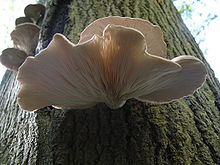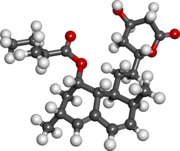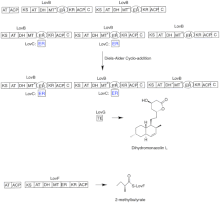
Statins are a class of medications that reduce illness and mortality in people who are at high risk of cardiovascular disease. They are the most commonly prescribed cholesterol-lowering drugs, and are also known as HMG-CoA reductase inhibitors.

The mevalonate pathway, also known as the isoprenoid pathway or HMG-CoA reductase pathway is an essential metabolic pathway present in eukaryotes, archaea, and some bacteria. The pathway produces two five-carbon building blocks called isopentenyl pyrophosphate (IPP) and dimethylallyl pyrophosphate (DMAPP), which are used to make isoprenoids, a diverse class of over 30,000 biomolecules such as cholesterol, vitamin K, coenzyme Q10, and all steroid hormones.

Atorvastatin, is a statin medication used to prevent cardiovascular disease in those at high risk and to treat abnormal lipid levels. For the prevention of cardiovascular disease, statins are a first-line treatment. It is taken by mouth.

Simvastatin, sold under the brand name Zocor among others, is a statin, a type of lipid-lowering medication. It is used along with exercise, diet, and weight loss to decrease elevated lipid levels. It is also used to decrease the risk of heart problems in those at high risk. It is taken by mouth.

Fluvastatin is a member of the statin drug class, used to treat hypercholesterolemia and to prevent cardiovascular disease.

Pravastatin, sold under the brand name Pravachol among others, is a statin medication, used for preventing cardiovascular disease in those at high risk and treating abnormal lipids. It is suggested to be used together with diet changes, exercise, and weight loss. It is taken by mouth.

Cerivastatin is a synthetic member of the class of statins used to lower cholesterol and prevent cardiovascular disease. It was marketed by the pharmaceutical company Bayer A.G. in the late 1990s, competing with Pfizer's highly successful atorvastatin (Lipitor). Cerivastatin was voluntarily withdrawn from the market worldwide in 2001, due to reports of fatal rhabdomyolysis.

HMG-CoA reductase is the rate-controlling enzyme of the mevalonate pathway, the metabolic pathway that produces cholesterol and other isoprenoids. HMGCR catalyzes the conversion of HMG-CoA to mevalonic acid, a necessary step in the biosynthesis of cholesterol. Normally in mammalian cells this enzyme is competitively suppressed so that its effect is controlled. This enzyme is the target of the widely available cholesterol-lowering drugs known collectively as the statins, which help treat dyslipidemia.

Mevastatin is a hypolipidemic agent that belongs to the statins class.

Monascus purpureus is a species of mold that is purplish-red in color. It is also known by the names ang-khak rice mold, corn silage mold, maize silage mold, and rice kernel discoloration.

Pitavastatin is a member of the blood cholesterol lowering medication class of statins.

Akira Endo is a Japanese biochemist whose research into the relationship between fungi and cholesterol biosynthesis led to the development of statin drugs, which are some of the best-selling pharmaceuticals in history.

Mexazolam is a drug which is a benzodiazepine derivative. Mexazolam has been trialed for anxiety and was found to be effective in alleviating anxiety at one week follow-up. Mexazolam is metabolised via the CYP3A4 pathway. HMG-CoA reductase inhibitors including simvastatin, simvastatin acid, lovastatin, fluvastatin, atorvastatin and cerivastatin inhibit the metabolism of mexazolam, but not the HMG-CoA reductase inhibitor pravastatin. Its principal active metabolites are chlorodesmethyldiazepam and chloroxazepam.
The discovery of HMG-CoA (3-hydroxy-3-methylglutaryl-CoA) reductase inhibitors, called statins, was a breakthrough in the prevention of hypercholesterolemia and related diseases. Hypercholesterolemia is considered to be one of the major risk factors for atherosclerosis which often leads to cardiovascular, cerebrovascular and peripheral vascular diseases. The statins inhibit cholesterol synthesis in the body and that leads to reduction in blood cholesterol levels, which is thought to reduce the risk of atherosclerosis and diseases caused by it.

Lapaquistat (TAK-475) is a cholesterol-lowering drug candidate that was abandoned before being marketed.

Pleurotus pulmonarius, commonly known as the Indian oyster, Italian oyster, phoenix mushroom, or the lung oyster, is a mushroom very similar to Pleurotus ostreatus, the pearl oyster, but with a few noticeable differences. The caps of pulmonarius are much paler and smaller than ostreatus and develops more of a stem. P. pulmonarius also prefers warmer weather than ostreatus and will appear later in the summer. Otherwise, the taste and cultivation of the two species is generally described as largely the same. Another similar species, North America's Pleurotus populinus, is restricted to growing on aspen and cottonwood.

Pleurotus citrinopileatus, the golden oyster mushroom, is an edible gilled fungus. Native to eastern Russia, northern China, and Japan, the golden oyster mushroom is very closely related to P. cornucopiae of Europe, with some authors considering them to be at the rank of subspecies. In far eastern Russia, P. citrinopileatus, they are called iI'mak, is one of the most popular wild edible mushrooms.
Medicinal fungi are fungi that contain metabolites or can be induced to produce metabolites through biotechnology to develop prescription drugs. Compounds successfully developed into drugs or under research include antibiotics, anti-cancer drugs, cholesterol and ergosterol synthesis inhibitors, psychotropic drugs, immunosuppressants and fungicides.
A steroidogenesis inhibitor, also known as a steroid biosynthesis inhibitor, is a type of drug which inhibits one or more of the enzymes that are involved in the process of steroidogenesis, the biosynthesis of endogenous steroids and steroid hormones. They may inhibit the production of cholesterol and other sterols, sex steroids such as androgens, estrogens, and progestogens, corticosteroids such as glucocorticoids and mineralocorticoids, and neurosteroids. They are used in the treatment of a variety of medical conditions that depend on endogenous steroids.
Bempedoic acid, sold under the brand name Nexletol among others, is a medication for the treatment of hypercholesterolemia.


























